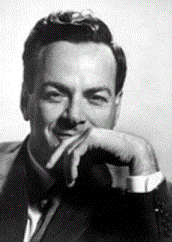

|
"To those who do not know mathematics it is difficult to get across a real feeling as to the beauty, the deepest beauty, of nature."
Richard Feynman. The Character of Physical Law
Theories of the known, which are described by different physical ideas, may be equivalent in all their predictions and hence scientifically indistinguishable. However, they are not psychologically identical when trying to move from that base into the unknown. For different views suggest different kinds of modifications which might be made and hence are not equivalent in the hypotheses one generates from them in one's attempt to understand what is not yet understood. [1966]
For a successful technology, reality must take precedence over public
relations, for Nature cannot be fooled.
“The first principle is that you must not fool yourself – and you are the easiest person to fool.”
cmt: This maxim motivates us to be critical of our research or actions. Non autoassolversi.
Being wrong isn’t a bad thing like they teach you in school. It is an opportunity to learn something.
If you find science boring you're learning it from a wrong teacher.
Rory Coker
2,0 su 5 stelle. When something has been lost, it's not always wise to recover
it...
12 aprile 2019 - Pubblicato su Amazon.com
Over 3 quarters during 1961-63, the great physicist Richard Feynman famously
taught an introductory course in physics that was required of all undergraduate
students at Caltech. The audio tape recordings of Feynman's lectures, plus
photos of his writings on the blackboards, were used to create the famous three
"big red books", THE FEYNMAN LECTURES ON PHYSICS.
An introduction in FEYNMAN'S TIPS ON PHYSICS by Matthew Sands tells the story of
how the course and these books came to be, with additional information provided
from an old interview with Robert Leighton.
There were 4 Feynman lectures omitted from the big red books, and thought to be lost. They have since been recovered and are presented here, with much supplementary material. Three of the lectures have Feynman reviewing the basic physics and mathematics needed for the course, and working some examples applying those principles, while a final lecture is devoted to a then-spectacular technological application of basic physics, namely inertial guidance.
What's wrong with the book? Well, for one thing, Feynman's presentation of the needed basic physics is completely standard. It was not necessary to recover it. But the main difficulties show up right away when Feynman starts to work examples. He must have been guided by the fact that most students in his class were engineering majors, and by the principle that the problems solved should be nontrivial, and in fact quite difficult. So the examples he solves are mainly based on a fiendish mechanical device, a box with two hinged rods attached to it. One rod is also attached by a hinge to the floor, while the other rod has a roller at the floor end. The examples he solves involve both static and dynamic aspects of the system. And as Feynman emphasizes over and over, he himself has horrific difficulties solving these problems. He reports failure after failure, mistaken assumptions, algebraic errors, numerical errors, errors in copying equations from one line to another, sign errors, etc., etc., etc. So the impression given to his horrified students was that physics is indeed too hard for almost everyone, that problems are solved mainly by secret tricks and by making assumptions that could never have been guessed or justified initially. And that you must be willing to devote many, many hours to solving any one of a long set of problems that constitutes homework for that week!
About the last third of the book consists of a list of the kinds of problems students taking the course in 1961 - 3 were assigned as homework. The problems are stated, but not solved. There's a list of "naked answers" at the end. None of these problems is in any way unusual or distinctive. They were standard end-of-chapter problems that could be found in any university-level physics text in those days (I know, I was there).
These days Feynman is often billed as "the great explainer," but as Leighton and Sands note in the material at the front of this book, Feynman in class sometimes gave as many as three different explanations for the same phenomenon, and these explanations were in Feynmanese rather than English, so were quite unclear. In creating the big red books, it was Leighton and Sands who picked one of the explanations and made it as clear as possible.